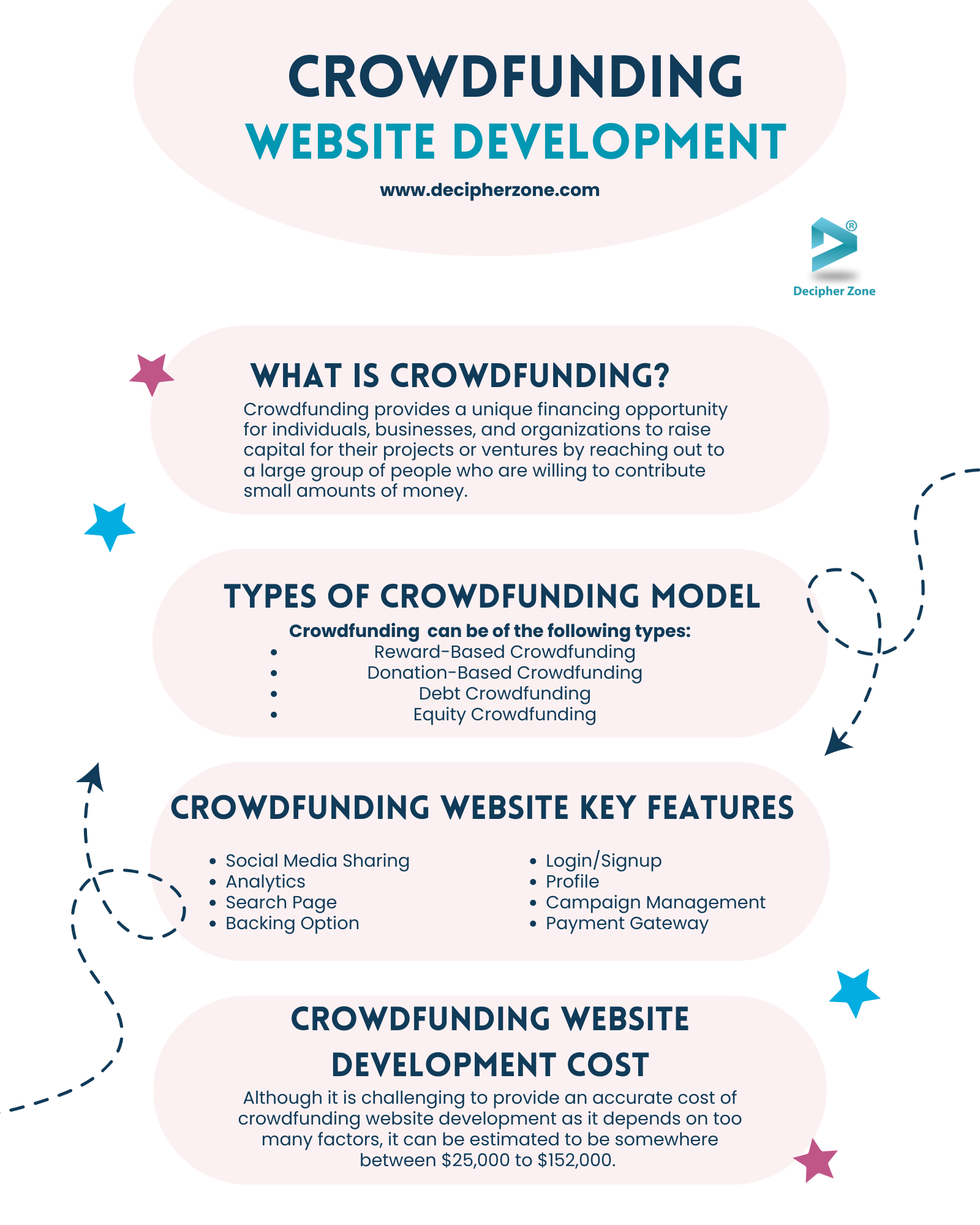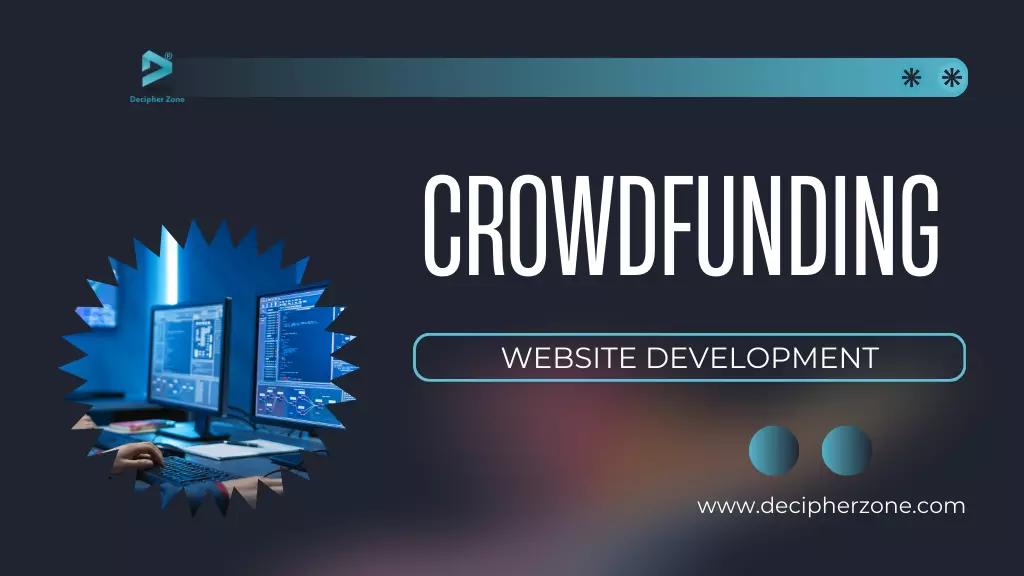Crowdfunding Website Development: Types, Features and Cost. Every new business requires funding to establish themselves in the market. And, crowdfunding might be the solution for it! With the ability to raise extra money to bring your creative product to life, crowdfunding has become a popular way for startups to establish themselves.
In fact, the global crowdfunding market is expected to grow at a CAGR of 14.5% between 2023 and 2030 and reach USD 3.62 billion by 2030, according to Fortune Business Insights.
Crowdfunding Website Development: Types, Features and Cost
And if you're interested in owning a crowdfunding platform like Crowdrise or Kickstarter, you're in the right place! In this blog, we'll take a closer look at how to develop a successful crowdfunding platform. We're going to embark on an exciting journey, so buckle up!
What is Crowdfunding?
Crowdfunding provides a unique financing opportunity for individuals, businesses, and organizations to raise capital for their projects or ventures by reaching out to a large group of people who are willing to contribute small amounts of money. It is a collaborative approach that harnesses the power of the crowd to support ventures that may otherwise find it difficult to secure traditional funding.
Read More: 7 Technologies Shaping The Future of Fintech
Crowdfunding is facilitated through online platforms that enable project creators to showcase their ideas, engage with potential supporters, and collect donations from a global audience. This innovative approach to fundraising has opened doors for many entrepreneurs and creatives to bring their ideas to life and make an impact in their communities.
Types of Crowdfunding Models
Crowdfunding websites can be of the following types:
-
Reward-Based Crowdfunding
-
Donation-Based Crowdfunding
-
Debt Crowdfunding
-
Equity Crowdfunding
Reward-Based Crowdfunding
This crowdfunding allows donors to earn incentives or rewards on the donated amount. Usually, these rewards include free products or services from the fundraiser company, handmade items, or other prizes. The reward-based crowdfunding works best for organizations offering tangible products to customers or startups that want to test their products in the market.
Donation-Based Crowdfunding
Donation-based crowdfunding is a method where a community or individual seeks small donations from a large number of people. The donations are used to fund a specific cause or idea, and the donors do not receive any financial return.
This type of crowdfunding is a powerful way for people to come together and support important causes that can make a positive impact on society.
Read More: Top Fintech Industry Trends for 2023
Equity Crowdfunding
Equity crowdfunding, also known as crowd equity, is a financing model in which a large number of investors pool their funds to invest in a company in exchange for a few percent ownership.
This type of funding is particularly suitable for small and medium-sized businesses looking to raise a significant amount of capital to grow their business. As an investor, you can expect to receive a financial return on your investment and a share of profits in the form of a distribution or dividend.
Debt Crowdfunding
Debt crowdfunding, also known as peer-to-peer crowdfunding, is a popular option for entrepreneurs and startups looking to raise funds quickly. With this approach, the fundraiser borrows money from donors or contributors and agrees to repay it with interest. Unlike equity crowdfunding, debt crowdfunding allows business owners to retain control of their company without having to give up equity.
The repayment terms, including interest rates and payment period, are typically set by the borrower. Debt crowdfunding offers a flexible and customizable financing solution for businesses of all sizes.
Read More: Loan Lending App Development Cost, Features, and Steps
Key Features of a Successful Crowdfunding Website
A few core features that a crowdfunding platform can’t prevail without are:
-
Login / Sign Up
-
Profile
-
Campaign Management
-
Payment Gateway
-
Social Media Sharing
-
Analytics
-
Search Page
-
Backing Options
Login / Sign Up
A crowdfunding website must have a login and sign-up feature. This feature enables users to easily register and log in to their accounts. This step is essential for restricting certain actions to only registered users, such as creating new campaigns, supporting existing ones, liking projects, or following their creators.
Profile
Once a user signs up for the app using their email, phone, or social media accounts, they can conveniently enter their personal and payment information to create their profile. This allows investors and fundraisers to easily verify the user's identity, making the crowdfunding process smoother and more efficient.
Read More: Stock Trading Web App Development
Campaign Management
The crowdfunding website must have the tools to create a fundraising campaign. There should be an interactive interface that helps in filling in important information for the campaign quickly. This information includes primary data about the project category, owner, location, description, campaign duration, etc.
Payment Gateway
When someone creates a fundraising campaign, they may receive the funds either when they reach their goal or when the campaign ends depending on the rules of the platform. In the case of a backer contributing to a project or company, the money is transferred to an escrow account of the platform, where it remains until the end of the campaign.
To enable sponsors from different countries to finance projects globally, it is crucial to integrate the most popular payment gateways with multiple options. This will increase opportunities for backers to contribute to campaigns using their preferred payment method.
Read More: Business Intelligence Software Development

Social Media Sharing
The crowdfunding website should come with the ability to share the campaigns through social media channels, resulting in better chances to receive donations.
Analytics
A well-managed account system is crucial for effective fundraising. A dashboard is an analytical tool that shows key statistics and progress, such as reward popularity, funding sources, average deposit payment, and grant balance. It helps fundraisers track the project's development, understand whether it will reach its goal, and give insights on how to motivate investors.
By using a dashboard, creators can easily monitor the progress, including the amounts raised, days remaining, and average donations. Understanding the needs of different users can help improve the analytics criteria and user experience, keeping people engaged with your crowdfunding app. Please see the picture below for the most common statistics.
Read More: Revenue Management Software Development
Search Page
Adding a search feature will allow investors to find the projects that pique their interest the most. The search feature should integrate the possibility of choosing project timing and categories.
Backing Options
Crowdfunding has become a popular way for individuals and businesses to raise funds for their projects. With the rise of crowdfunding platforms, sponsors are now presented with various financing options that allow them to choose the amount of money to invest and the desired rewards. This option widens the opportunities for backers, making it easy to support selected campaigns and contribute to their success.
Read More: Custom API Development - Benefits and Drawbacks
How Does a Crowdfunding Platform Make Money?
Crowdfunding platforms have various ways of generating revenue, and the primary method is through platform fees. There are two types of fundraising campaigns: All or Nothing Campaigns and Keep What You Raise campaigns. In All or Nothing campaigns, startups, entrepreneurs, or individuals must reach their fundraising goals to keep the funds they raised.
If the campaign is successful, the platform usually takes a 5% fee. On the other hand, Keep What You Raise campaigns allow fundraisers to keep the number of funds raised, even if they don't reach their target.
In this type of campaign, platforms typically charge a fee of 8-10%. Additionally, most crowdfunding platforms charge a payment processing fee, which averages around 3%, but it may vary from one platform to another.
Cost of Developing a Crowdfunding Website
Although it is challenging to provide an accurate cost of crowdfunding website development as it depends on too many factors, it can be estimated to be somewhere between $25,000 to $152,000. Some of the elements affecting the cost of crowdfunding website development include its design, development, features (basic and advanced), platform used, tech stack, etc.
Wrapping it Up
Effective planning, adherence to legal requirements, user-centric design, and keeping up with technological advancements are key factors in the development of a successful crowdfunding platform. Entrepreneurs can create a platform that not only attracts backers but also fosters the growth of innovative and impactful projects by understanding the various types of crowdfunding, essential features, and crucial steps involved.
With the right strategy, a well-implemented tech stack, and a clear understanding of revenue models, crowdfunding websites can become a catalyst for positive change in several industries. In conclusion, the development of a successful crowdfunding website demands a comprehensive approach to all aspects of the platform, which can ultimately lead to a thriving community of backers and project creators.
FAQs: Crowdfunding Website Development
What are the different crowdfunding models?
Reward-based crowdfunding, donation-based crowdfunding, equity crowdfunding, and debt crowdfunding are the 4 main types of crowdfunding models being used in the market.
How can I ensure the security of my crowdfunding platform?
To provide security in the crowdfunding platform, your website must comply with GDPR, Anti-Money Laundering (AML), Consumer Data Rights (CDR), Know Your Customer (KYC), CP Act, PCI-DSS, Sarbanes Oxley, and Gramm-Leach-Bliley Act (GLBA).
What is the cost of building a crowdfunding website?
Depending on the features, tech stack, complexity, storage, development team, team location, etc. the cost of building a crowdfunding platform is somewhere between $25,000 to $152,000.

